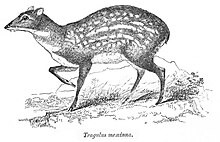Moschiola
In today's world, _Moschiola__ has become a topic of great relevance and interest to a wide spectrum of people. Whether _Moschiola__ is an iconic figure, a fundamental concept or a significant date, its importance transcends borders and cultures. In this article, we will explore the different aspects related to _Moschiola__, from its impact on society to its influence on history. Through detailed analysis, we will seek to understand how _Moschiola__ has shaped our world and remains relevant today. This article aims to provide a comprehensive and enriching vision of _Moschiola__, inviting the reader to reflect and delve into its meaning and relevance in everyday life.
| Moschiola | |
|---|---|

| |
| "Tragulus meminna" from the Fauna of British India | |
| Scientific classification | |
| Domain: | Eukaryota |
| Kingdom: | Animalia |
| Phylum: | Chordata |
| Class: | Mammalia |
| Order: | Artiodactyla |
| Family: | Tragulidae |
| Genus: | Moschiola Gray, 1852 |
| Type species | |
| Moschus meminna Erxleben, 1777
| |
Moschiola, the spotted chevrotains, are a genus of small even-toed ungulates in the family Tragulidae. They are found in forests in India, Sri Lanka and perhaps Nepal, and have pale-spotted or -striped upperparts unlike the other Asian members of the family, the mouse-deer of the genus Tragulus.[1]
In former times, the genus was usually treated as monotypic. Described as Moschus meminna, for most of the time the name Tragulus meminna was used, but changed to Moschiola meminna eventually. In the 21st century, this is increasingly divided into up to three parapatric species:[2]
| Image | Scientific name | Common Name | Distribution |
|---|---|---|---|
 |
M. meminna sensu stricto | Sri Lankan spotted chevrotain | drier parts of Sri Lanka |
 |
M. indica | Indian spotted chevrotain | South Asian mainland north to Nepal |
 |
M. kathygre | Yellow-striped chevrotain | humid parts of Sri Lanka |
References
- ^ Nowak, R. M. (eds) (1999). Walker's Mammals of the World. 6th edition. Johns Hopkins University Press.
- ^ Groves, C.; Meijaard, E. (2005). "Intraspecific variation in Moschiola, the Indian Chevrotain" (PDF). The Raffles Bulletin of Zoology Supplement. 12: 413–421.
External links